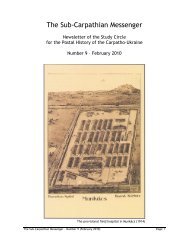The Sub-Carpathian Messenger - Jay T. Carrigan
The Sub-Carpathian Messenger - Jay T. Carrigan
The Sub-Carpathian Messenger - Jay T. Carrigan
- No tags were found...
You also want an ePaper? Increase the reach of your titles
YUMPU automatically turns print PDFs into web optimized ePapers that Google loves.
Cut-out from this letter (with text of complaint in English)<strong>The</strong> Hungarian policy of the 1930s was guided by the principle to break this circleof hostile neighbours. With much interest they watched the rise in power of theGerman Empire under its demonic and unpredictable chancellor Hitler. From 1936on they felt that this new power was slowly eclipsing France and Italy in theirdomain. Spring 1938 brought then the forced union of the weak Austrian republicwith Germany and made Hitler their immediate neighbour in the west. <strong>The</strong>y certainlycelebrated with him when in autumn 1938 he tricked the Western Powersinto accepting his Munich agreements and took large junks out of the defenselessCzechoslavakian republic. <strong>The</strong> Hungarians followed suit and gathered parts of Slovakiaand the <strong>Sub</strong>-<strong>Carpathian</strong>s for themselves.<strong>The</strong> most eastern part of the Czechoslovakian republic, now separated from themain body of the state, was still a thorn in their hide. In the north another enemyof the Czechs, the Poles, had come under growing pressure from Germany, andwere on the look-out for new political friends to sustain their fight for life. Historicallythere has never been an extended phase of enmity between Hungary andPoland; on the contrary, for a long time they had had similar political and socialstructures, and both despised the Czechs and the Ukrainians.When in the evening of 14 March 1939 the Republic of the Carpatho-Ukraine declareditself independent, Hungary was determined to kill this unwanted offspringin its childbed. One day later, in the afternoon of 15 March 1939, its well-armedtroops had swept away the brave but weak resistance of the local Sitch forces andhad occupied Chust. <strong>The</strong> “Republic for a Day” was over.<strong>The</strong> British watched all this with much suspicion. Already during the “Red Revolution”in Hungary, i. e. the short-lived existence of the Hungarian Soviet Republicunder the leadership of Béla Kun, they had feared that this was just a pre-text forthe Russian bear to step over the <strong>Carpathian</strong>s and establish itself both politicallyand in its military capacity in the eastern part of Central Europe. Also the erraticdevelopment of German policies kept them on the watch.So in the beginning of the year 1939 they sent one Michael Winch to this area whoworked as a journalist for some British newspapers. This, of course, was just acover job because his real employer was MI6, the part of the Secret Service responsiblefor the non-British countries. He was accompanied on this trip by a youngPolish photographer. Both stayed in the area and were eyewitnesses of all theevents unfolding until the Hungarians marched in and they had to quickly leave thecountry.Michael Winch wrote a book about all this – “Republic for a Day” being its title. <strong>The</strong>book is hard to find and even harder to get (I bought it in the USA for a definitelyhair-raising price).<strong>The</strong> <strong>Sub</strong>-<strong>Carpathian</strong> <strong>Messenger</strong> – Number 1 (November 2008) Page 7













